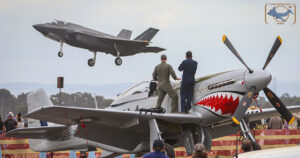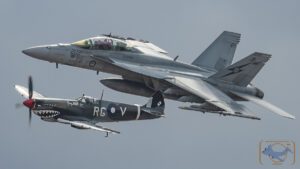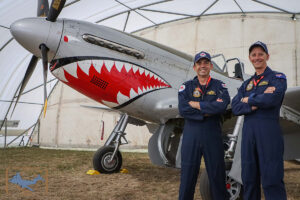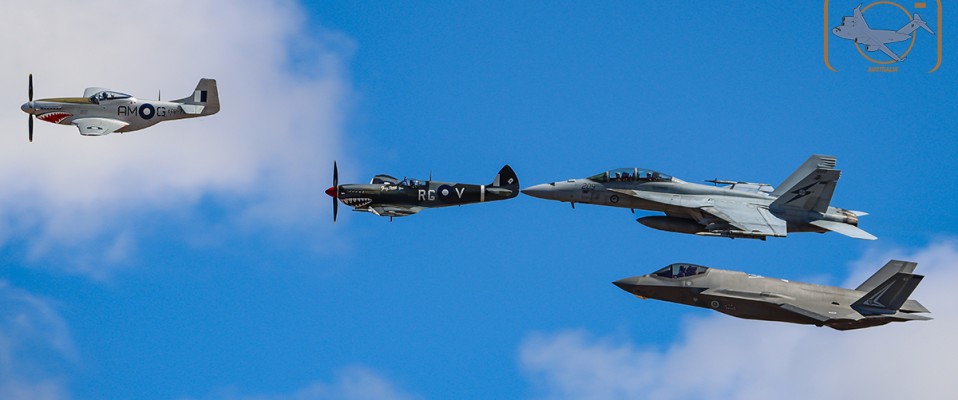RAAF showcasing its Heritage with special formation flight.
Royal Australian Air Force highlights its heritage with 100 Squadron teaming with Air Combat Group for special formation.
Article: Jaryd Stock
Images: Ryan Imeson
A CAC-18 Mustang and Supermarine Mk. VIII Spitfire have flown in a formation with the next generation of air power for the first time, at the Australian International Airshow.
The heritage aircraft from 100 squadron which is based at Temora and Point Cook were joined by a No.1 Squadron F/A-18F Super Hornet and a No.2 Operational Conversion Unit F-35A Lightning II as the sun set over the Avalon airfield.
Air Force Heritage aircraft are always crowd pleasers at air shows but this line-up was an amazing arrival.

100 Squadron’s Flight Lieutenant Christopher Tulk led the swan formation in the Mustang, followed by the Spitfire and then the F/A-18F Super Hornet and the F-35A Lightning II.
“It’s a formation that we’ve never flown before and no one’s ever seen,” he said.
Flight Lieutenant Tulk has carved out a distinguished career in aviation. From a teenage glider pilot in Barnawartha, North East Victoria, to a skilled display aviator, he is passionate about preserving Australia’s aviation heritage.
His fascination with aviation took flight early.
“I’ve wanted to be an Air Force pilot for as long as I can remember,” he said.
Despite having no family ties to aviation, his first glider experience at 14 and solo flight at 15 cemented his ambition.

“I spent all my pocket money on aviation magazines and absorbed everything about the Air Force,” he recalled. His dedication paid off when he was accepted into pilot training with Air Force in 1991.
Based at RAAF Base Point Cook and the Temora Aviation Museum, the squadron operates airworthy warbirds and conduct flying displays that honour veterans and inspire future generations of aviators.
“The display day itself is almost the easiest part, with preparation in the lead-up to being key” Flight Lieutenant Tulk said.
Meticulous planning precedes every event, from crafting routines to assessing risks and logistics.
Each day begins with weather checks, authorisation briefs, and aircraft inspections.
“Once we’re strapped in and ready to start the engine, the hard work is done,” he said.
Safety remains paramount, with pre-flight briefings addressing weather impacts, potential obstacles and emergency procedures.
“We ensure everyone is physically fit and aligned on the flight plan,” Flight Lieutenant Tulk said
“We often walk through the flight to guarantee a shared understanding.”
While ground crews conduct pre-flight inspections, Flight Lieutenant Tulk and his team verify fuel and oil levels, assess flight controls and check for potential issues.
“Flying these older aircraft requires extra care,” he said, acknowledging the challenges of low-level aerobatics and formation manoeuvres.

Post-flight debriefings focus on safety and performance refinement.
“We discuss what went right and wrong and explore ways to improve,” he said.
It’s incredible to fly a fighter nearly 70 years older than the F-35A Lightning II, these aircraft have so much history, and it’s beautiful machine to fly. I get a kick out of flying it every single time.”
Jaryd Stock is based in Sydney Australia. He has been a die-hard aviation enthusiast from a young age when he was chauffeured around by his father to various airshows and airports around Australia. At his first Airshow he witnessed the awesomeness of a General Dynamics F-111C and immediately fell in love with aviation.
Jaryd picked up a camera at a young age and has never looked back. He now combines photography and writing to highlight “Downunder” aviation; especially U.S. DoD units. Jaryd uses Nikon cameras and lenses.

